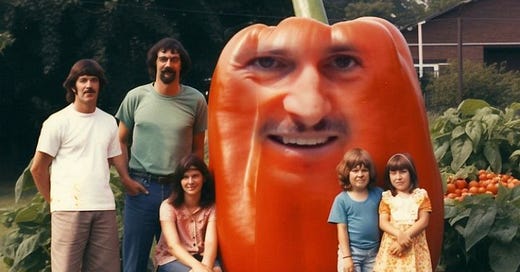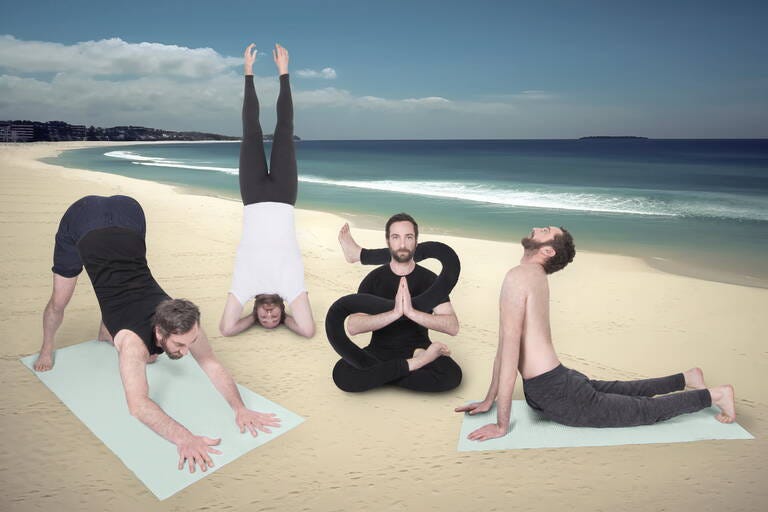Born in 1990 in the Vosges, Eastern France, Robin Lopvet is a multimedia visual artist working in the fields of visual puns, recycling economy, parody, DIY and fun. His work is rooted in collage and digital aesthetics, so he found ways to incorporate AI image generation in his practice early. We spoke about memes, how AI can offer solutions to copyright issues, and, why you should learn to write prompts soon.
FS Hi Robin, for the people that don’t know you, how would describe your work and what role digital tools play in it?
RL I mainly use photography, but in a way that is more like painting or illustration. Photography is the raw material, which I use to make collages. I work a lot in still lifes, but most of it is playful and fun. I do a lot of things without any meaning or subject matter in the in the first place. It's pure enjoyment.
FS Is it your own photos or found material?
RL I use my own photos, but also other kinds of images.
FS The reason that we’re speaking today is that I saw you started to use Midjourney. Why is that?
RL For me, the question with Midjourney is: When everyone can make images and has access to the same tool, how do you use it in a way that's your own? And the answer I got for me is that I use Midjourney to generate images that I use as part of my collages.
For example, I made a picture about influencers. I shot my model and made multiple arms. On top of each hand, I got an item that represents what the influencer does. I generated a salad and burger, a plane ticket and integrated them into my composition. Before, when I needed elements for a collage, I went on wiki commons to find a CC picture that I could use. Now I just generate the parts that I don’t have, I take them into Photoshop, cut them, twist them and, bring them together with other parts. I use it more as a complementary tool. Working this way, I don't have any problems with copyrights.
FS I found it interesting that you're using the hashtag #postphotography on your photos. That’s a term coined in 1992 by William J. Mitchell, who claimed that with the introduction of digital photography, photography as we knew it had ceased to exist. What is post-photography for you?
RL I don't know how accurate this is, but for me what I do is not pure photography, and it's not drawing, or illustration. It’s kind of in between. So, I found post-photography could fit in that way.
FS I found this quote in Mitchell’s book that seems very much related to your practice. He wrote 30 years ago: “… electronic collage allows ready combination of synthesized images with captured ones - to place synthesized images in real scenes, or real objects in synthesized scenes. Just as execution of a brush stroke is a fundamental painting operation and exposure is a fundamental photographic operation, so selection, transformation, and assemblage of captured, synthesized, and drawn fragments to reconstitute a mise en image are fundamental operations on the digital image”. For him, the possibility to disassemble and reassemble reality was the key feature of digital photography.
RL I love this quote, it seems relevant to my practice and how I see things.
FS In 2018, your work “dust storm dog” became a viral meme. How did that happen?
RL Oh, that’s a good example, because today I would not do this work in the same way. It was an image that I made in 5 minutes at work, while I didn't have anything to do. I used two images that I found on the internet for the collage. I can say the collage is mine, but I didn’t have permissions and today that is bothering me.
So yeah, it became a meme, and the thing is, when that happens, you basically lose all your control, anyone starts using it. At one point there was even a website, where they print your picture on items like hats and t-shirts and sell them. My collage ended up in this. I asked them to remove it, but they didn't. So, I bought some of the items, signed them and sold them on my website.
FS So it went full circle (laughs). How did you feel?
RL At first, I was angry, it’s not easy to watch people sell your pictures without your permission. But it's the game on the internet. Basically, when you put an image on the Internet, you can lose control of it, that's the rule.
FS So do you think copyright will survive?
RL Thanks to AI tools, copyrighted contents are easier to detect nowadays, think of music on YouTube for example, you cannot monetize easily on other people’s work. I really like the idea of sampling: to take elements of things, manipulate and distort them, but it's becoming harder. I think it's going to be a lot of work for copyrighters just to figure out how the whole thing will work.
FS Who owns the copyright of generated image?
RL For me it's only the artist: when you take a photo, you basically take parts of the of the world that don't belong to you. You don’t own the people, the car(s) or the streets. But you can take an image of them and do whatever want with it. But what it shows doesn't belong to you.
FS But is it comparable? The image generators can also imitate artistic styles.
RL I think it depends. It is more of a problem when for example, people use generated voices that sound like Kendrick Lamar or Drake, and make fake songs. For me, the focus is: how do you do things in your own style? Because what I don't like about Midjourney is that everything it generates has the same look. So how do you use the tool in ways that are unique and interesting. It's fun to make an image that looks like someone else’s, you can make friends with that, but it’s not artistically relevant. You know, you don't want to steal another person’s style, you want your own.
FS So last question, you can answer completely subjective or speculative: Where do you see photography in ten years?
RL I think we will still need a lot of people for photography, for example products and fashion. But the sets will be much smaller. You can get rid of models and light assistants, you’ll have just one photographer that takes pictures of the product and one person that writes prompts, generates models and environments. With that, you can shoot a whole campaign. I think AI is comparable to when digital cameras arrived in photography: Nowadays no one is going to use an analogue camera to shoot 200 product pictures a day. So, I think is going to change the habits, but we still have to figure out how to use it in in a proper way.
With AI, we are going to get rid get of people who shoot stock pictures. Photographers will be forced to have their own personal style, because otherwise you can just write a prompt and there’s your picture. If you do basic stuff without any soul, you're done.
*
Dive deeper:
Find more of Robin Lopvet’s work on instagram and on his website
William J. Mitchell: The Reconfigured Eye: Visual Truth in the Post-Photographic Era, MIT Press, 1992. p. 163, You can read the very interesting last chapter online
There was a discussion about post-photography again in 2014 when Robert Shore published a compendium called: Post-Photography: The Artist with a Camera, Laurence King Publishing, 2014. See a Hyperallergic Article here
An even more timely approach to the idea of post-photography was also Milo Kellers project Argumented Photography at ECAL in 2017








